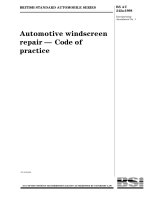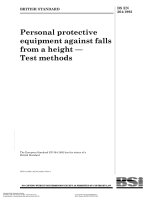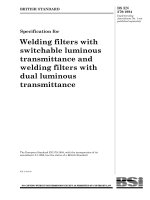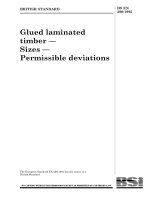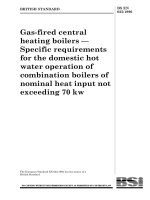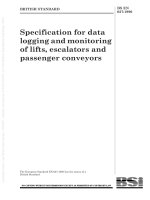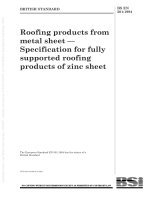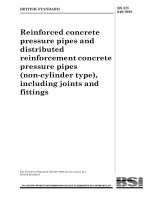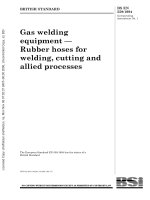Bsi bs en 50178 1998 (1999)
Bạn đang xem bản rút gọn của tài liệu. Xem và tải ngay bản đầy đủ của tài liệu tại đây (856.81 KB, 102 trang )
Licensed Copy: Institute Of Technology Tallaght, Institute of Technology, Mon Apr 23 21:06:57 GMT+00:00 2007, Uncontrolled Copy, (c) BSI
BRITISH STANDARD
Electronic equipment
for use in power
installations
The European Standard EN 50178:1997 has the status of a
British Standard
ICS 29.240.01
NO COPYING WITHOUT BSI PERMISSION EXCEPT AS PERMITTED BY COPYRIGHT LAW
| BS EN
|
|
| 50178:1998
|
|
|
| Incorporating
| Corrigendum No. 1
|
|
|
|
|
|
|
|
|
|
|
|
|
|
|
|
|
|
|
|
|
|
|
|
|
|
|
|
|
|
|
|
|
|
|
|
|
|
|
|
|
|
|
|
|
|
|
|
|
|
|
|
|
|
|
|
|
|
|
|
|
|
|
|
|
|
|
|
|
|
|
|
|
|
|
|
|
|
|
|
|
|
|
|
|
|
|
|
|
|
|
|
|
|
|
|
|
|
|
|
|
|
|
|
|
|
|
|
|
|
|
|
|
|
|
|
|
|
|
|
Licensed Copy: Institute Of Technology Tallaght, Institute of Technology, Mon Apr 23 21:06:57 GMT+00:00 2007, Uncontrolled Copy, (c) BSI
BS EN 50178:1998
National foreword
This British Standard is the English language version of EN 50178:1997.
The UK participation in its preparation was entrusted to Technical Committee
PEL/22, Static power convertor equipment, which has the responsibility to:
Ð aid enquirers to understand the text;
Ð present to the responsible European committee any enquiries on the
interpretation, or proposals for change, and keep the UK interests informed;
Ð monitor related international and European developments and promulgate
them in the UK.
A list of organizations represented on this committee can be obtained on request to
its secretary.
Cross-references
The British Standards which implement international or European publications
referred to in this document may be found in the BSI Standards Catalogue under the
section entitled ªInternational Standards Correspondence Indexº, or by using the
ªFindº facility of the BSI Standards Electronic Catalogue.
A British Standard does not purport to include all the necessary provisions of a
contract. Users of British Standards are responsible for their correct application.
Compliance with a British Standard does not of itself confer immunity
from legal obligations.
Summary of pages
This document comprises a front cover, an inside front cover, the EN title page,
pages 2 to 99 and a back cover.
The BSI copyright notice displayed throughout this document indicates when the
document was last issued.
Sidelining in this document indicates the most recent changes by amendment.
This British Standard, having
been prepared under the
direction of the Electrotechnical
Sector Committee, was published
under the authority of the
Standards Committee and comes
into effect on 15 December 1998
BSI 08-1999
ISBN 0 580 30453 1
Amendments issued since publication
Amd. No.
Date
Comments
10604
August 1999 Correction to Table 10
Corrigendum
Licensed Copy: Institute Of Technology Tallaght, Institute of Technology, Mon Apr 23 21:06:57 GMT+00:00 2007, Uncontrolled Copy, (c) BSI
EN 50178
EUROPEAN STANDARDS
NORME EUROPÊENNE
EUROPẰISHE NORM
October 1997
ICS 29.240.00
Descriptors: electrical installation, industrial electrical installation, electronic equipment, definitions, design, safety, protection against
electric shocks, protection against live parts, climatic conditions, electrical properties, mechanical properties, tests, marking
English version
Electronic equipment for use in power installations
EÂquipement eÂlectronique utilise dans les
installations de puissance
AusruÈstung von Starkstromanlagen mit
elektronischen Betriebsmitteln
This European Standard was approved by CENELEC on 1997-07-01. CENELEC
members are bound to comply with the CEN/CENELEC Internal Regulations which
stipulate the conditions for giving this European Standard the status of a national
standard without any alteration. Up-to-date lists and bibliographical references
concerning such national standards may be obtained on application to the Central
Secretariat or to any CENELEC member.
This European Standard exists in three official versions (English, French, German).
A version in any other language made by translation under the responsibility of a
CENELEC member into its own language and notified to the Central Secretariat has
the same status as the official versions.
CENELEC members are the national electrotechnical committees of Austria,
Belgium, Czech Republic, Denmark, Finland, France, Germany, Greece, Iceland,
Ireland, Italy, Luxembourg, Netherlands, Norway, Portugal, Spain, Sweden,
Switzerland and United Kingdom.
CENELEC
European Committee for Electrotechnical Standardization
Comite EuropeÂen de Normalisation Electrotechnique
EuropaÈisches Komitee fuÈr Elektrotechnische Normung
Central Secretariat: rue de Stassart 36, B-1050 Brussels
1997 CENELEC All rights of exploitation in any form and by any means reserved worldwide for CENELEC
Members.
Ref. No. EN 50178:1997 E
Licensed Copy: Institute Of Technology Tallaght, Institute of Technology, Mon Apr 23 21:06:57 GMT+00:00 2007, Uncontrolled Copy, (c) BSI
Page 2
EN 50178:1997
Foreword
This European Standard was prepared by the Task
Force CENELEC BTTF 60-1, Assembly of electronic
equipment.
A first draft was submitted to CENELEC enquiry
(6MP) in August 1994 but failed to be accepted. A
second draft was submitted to CENELEC enquiry
(2MP) in September 1995 and was accepted. The text
of the final draft was submitted to the Unique
Acceptance Procedure and was approved by
CENELEC as EN 50178 on 1997-07-01.
The following dates were fixed:
Ð latest date by which the EN has
to be implemented at national level
by publication of an identical
national standard or by
endorsement
(dop) 1998-06-01
Ð latest date by which the
national standards conflicting with
the EN have to be withdrawn
(dow) 2003-06-01
Annexes designated ªinformativeº are given for
information only. In this standard annexes A and B are
informative.
Annex A offers additional information e.g. as a basis
for design purposes. It also indicated items where new
standards are expected to be established. Functions or
characteristics presented in the informative annex A
may be used as options of the electronic equipment,
provided that test methods are specified and test
equipment is available. In any case, these points have
to be discussed and clarified between customer and
manufacturer.
Annex B is under consideration. It is intended to
contain tables with all important figures and values. It
shows a condensed overview on the conditions and
requirements for convenience of the user of the
standard.
The requirements of this European Standard are based
on basic or generic standards issued by IEC or CLC
where these standards exist. This is valid especially for
safety and environmental requirements. Additional
requirements are stipulated where necessary.
This European Standard is a harmonized standard for
electronic equipment for use in power installations
according to the Low Voltage Directive 73/23/EEC. No
additional requirements are to be met for compliance
with this directive.
Contents
Foreword
1
2
3
4
4.1
4.2
4.3
4.4
4.5
4.6
5
5.1
5.2
5.2.1
5.2.2
5.2.3
5.2.4
5.2.4.1
5.2.5
5.2.6
5.2.7
5.2.8
5.2.8.1
5.2.8.2
5.2.8.3
5.2.8.4
5.2.8.5
5.2.9
Page
2
8
8
10
16
16
16
Scope
Normative references
Definitions
Requirements for entire system
Normal function
Damage to persons or material
EE connected to unearthed supply
mains under condition of earth fault
Earthing requirements (grounding,
earthing and screening)
Wires and cables for interconnection
Fuses in neutral and protective
conductors
Safety requirements
General requirements
Requirements for EE with regard to
protection against electric shock
Requirements for protection against
electric shock
Protection against direct contact
Protection by means of insulation of
live parts
Protection by means of enclosures
and barriers
Distances
Discharge of capacitors
Built-in devices
EE for closed electrical operating
areas
Protection in the case of direct
contact
Protection by means of extra-low
voltage with protective separation
(SELV- and PELV-system
Protection by means of limitation of
the discharging energy
Protection by means of protective
impedance
Protection by using limited voltages in
control circuits
Connectors
Protection with regard to indirect
contact
17
17
17
17
18
18
20
20
21
21
21
22
22
22
22
22
22
22
22
23
23
23
BSI 08-1999
Licensed Copy: Institute Of Technology Tallaght, Institute of Technology, Mon Apr 23 21:06:57 GMT+00:00 2007, Uncontrolled Copy, (c) BSI
Page 3
EN 50178:1997
5.2.9.1
5.2.9.2
5.2.9.3
5.2.9.4
5.2.9.5
5.2.9.6
5.2.9.7
5.2.9.8
5.2.10
5.2.11
5.2.11.1
5.2.11.2
5.2.12
5.2.13
5.2.14
5.2.14.1
5.2.14.2
5.2.14.3
5.2.15
5.2.15.1
5.2.15.2
5.2.16
5.2.16.1
5.2.16.2
5.2.16.3
5.2.17
5.2.18
5.2.18.1
5.2.18.2
5.2.18.3
5.2.18.4
5.2.18.5
BSI 08-1999
Page
Insulation between live parts and
exposed conductive parts
23
Protective bonding
23
Rating of protective bonding
24
Protection against corrosion
24
Protective bonding conductor with
low cross-section
24
EE with voltage above a.c. 1 400 V or
d.c. 2 000 V
24
Interruption
24
Marking
24
Means of connection for the protective
conductor
24
Leakage current and fault current
24
High leakage current
24
Compatibility with
residual-current-operated protective
devices in case of low leakage current 25
Special features in EE for protective
class II
26
Decisive voltage
27
Solid insulation, insulation of circuits
29
Between circuits and exposed
conductive parts or accessible
surfaces of EE
29
Between circuits
29
Bridging of the insulation via
conductive parts
29
Clearances and creepage distances,
pollution degree
29
Clearances and creepage distances
29
Pollution degree
37
Clearances
37
Clearances between mains-circuits and
their environment
38
Clearances between non-mains-circuits
and their environment
39
Clearances within a circuit
40
Creepage distances
40
Protective separation
44
Constructive measures
45
Protective separation by double or
reinforced insulation
45
Protective separation by protective
screening
45
Clearances and creepage distances in
case of protective separation
46
Partial discharge
46
Page
5.2.18.6
5.3
5.3.1
5.3.1.1
5.3.1.2
5.3.1.3
5.3.1.4
5.3.2
5.3.2.1
5.3.2.2
5.3.2.3
6
Components and other electrical
sub-assemblies
Requirements for EEs in installations
with regard to protection against
electric shock
Protection with regard to direct
contact
Cables and leads
Connection of EE with protective
separation
Built-in devices in installations
EE in closed electrical operating areas
Protection with regard to indirect
contact
Leakage current through the
protective conductor
Permissible touch voltage
Protection of EE by residual-currentoperated protective device
Environmental requirements and
conditions
Climatic conditions
Temperature
Ambient air temperature
Cooling medium temperature
Humidity and air pressure
Pollution
Mechanical requirements (general)
Mechanical shock
Mechanical vibration
Immunity requirement to mechanical
vibration
Mechanical vibration emission
constraints
Sealing in case of liquid cooling
Sealing against dust ingress to EE
Electrical and electromagnetic
requirements
Conditions in the system (immunity
level for EE)
EE connected to a.c. supply mains
(immunity)
Supply voltage variation
Frequency
EE connected to d.c. supply mains
(immunity)
Short-circuit withstand capability
(immunity)
47
47
47
47
47
47
48
48
48
48
48
www.bzfxw.com
6.1
6.1.1
6.1.1.1
6.1.1.2
6.1.2
6.1.3
6.2
6.2.1
6.2.2
6.2.2.1
6.2.2.2
6.2.3
6.2.4
6.3
6.3.1
6.3.2
6.3.2.1
6.3.2.2
6.3.3
6.3.4
48
48
49
49
50
50
50
50
50
50
50
50
51
51
51
51
51
51
51
51
52
Licensed Copy: Institute Of Technology Tallaght, Institute of Technology, Mon Apr 23 21:06:57 GMT+00:00 2007, Uncontrolled Copy, (c) BSI
Page 4
EN 50178:1997
6.3.5
6.3.6
6.3.7
7
7.1
7.1.1
7.1.2
7.1.3
7.1.4
7.1.5
7.1.5.1
7.1.5.2
7.1.6
7.1.6.1
7.1.6.2
7.1.7
7.1.7.1
7.1.7.2
7.1.7.3
7.1.7.4
7.1.7.5
7.1.7.6
7.1.8
7.1.9
7.1.10
7.1.10.1
7.1.10.2
7.1.11
7.2
7.2.1
7.2.2
7.2.3
7.2.3.1
7.2.3.2
7.2.3.3
7.2.3.4
7.2.4
Page
Immunity from electromagnetic
disturbance
52
Effects of EE(s) on the system
(emission)
52
Rating of power electronic equipment 52
Requirements for electronic equipment 52
Design and construction
52
General
52
Quality and reliability
52
Working life
52
Insulation
52
Component selection and use
53
Selection criteria for components
53
Hazards arising from components
53
Power supply switching, fusing and
usage
53
Fire protection and fire risk
53
Operation under fault conditions
53
Construction
53
EE mounting practice Ð general
53
Cooling
53
Mechanical protection of equipment
and sub-units
53
Layout of components and equipment 53
Temperature of accessible parts
54
Fixing (mechanical retention of
components and sub-units)
54
Electrical connections
54
Multiple connectors and
plug-and-socket devices
54
Electrical conductors
54
Wires and cables for interconnection
54
Conventional wiring within EE
54
Reference conductor, functional
earthing
54
Marking, identification, documentation 54
Marking
54
Identification of equipment, sub-units,
position and terminals
55
Documentation
55
General
55
Operating documents
55
Instructions for transport,
maintenance, fault finding, repair
56
Test records
56
Drawings and diagrams
56
Page
8
8.1
8.2
8.3
8.3.1
8.3.2
8.3.3
8.3.3.1
8.3.3.2
8.3.3.3
8.3.3.4
9
9.1
9.1.1
9.1.1.1
9.1.1.2
9.1.1.3
9.1.1.4
9.1.2
9.1.3
9.2
Requirements for the assembly of
EE(s) in power installations
General
Fitting tolerances after assembly
Supply mains
Monitoring of insulation
Functional earthing
Design and protection of conductors
to and in EE
Power input conductors to EE
Conductors between separated parts
of an EE
Conductors on the load side of EE
Protective conductors
Testing
General
Tests and methods of testing
Type test
Routine test
Sample test
Site test
General conditions for testing
Verification procedure
Compliance with this European
Standard
Overview of tests
Performance of the tests
Visual inspections
Climatic environmental tests
Dry heat test
Damp heat test
Mechanical tests
Topple test
Vibration test
Seal test for liquid cooled EE
Safety related mechanical tests
Clearances and creepage distances
Non-accessibility test
Enclosure test
Suitability test of varnish or coating
Safety related electrical (dielectric)
tests
Impulse voltage test
A.c. or d.c. voltage insulation test
56
56
56
56
56
56
56
56
57
57
57
57
57
57
57
58
58
58
58
58
www.bzfxw.com
9.3
9.4
9.4.1
9.4.2
9.4.2.1
9.4.2.2
9.4.3
9.4.3.1
9.4.3.2
9.4.3.3
9.4.4
9.4.4.1
9.4.4.2
9.4.4.3
9.4.4.4
9.4.5
9.4.5.1
9.4.5.2
59
59
61
61
61
62
62
63
63
63
63
64
64
64
64
64
64
65
66
BSI 08-1999
Licensed Copy: Institute Of Technology Tallaght, Institute of Technology, Mon Apr 23 21:06:57 GMT+00:00 2007, Uncontrolled Copy, (c) BSI
Page 5
EN 50178:1997
9.4.5.2.1
9.4.5.2.2
9.4.5.2.3
9.4.5.2.4
9.4.5.3
9.4.5.4
9.4.5.5
9.4.6
9.4.6.1
9.4.6.2
9.4.6.3
9.4.7
Annex A
A.2
A.4
A.4.4
A.4.4.1
A.4.4.1.1
A.4.4.1.2
A.4.4.1.3
A.4.4.1.4
A.4.4.1.5
A.4.4.1.6
A.4.7
A.5
A.5.2.4
A.5.2.4.2
A.5.2.4.3
A.5.2.4.4
A.5.2.4.5
A.5.2.8
A.5.2.8.2
A.5.2.8.3
A.5.2.9.2
A.5.2.9.3
Page
Relation of a.c. or d.c. test voltage to
rated insulation voltage
66
Value and type of insulation test
voltage
66
Performing the insulation voltage test 67
Duration and verification of the a.c. or
d.c. voltage test
69
Partial discharge test
69
Insulation resistance test in the power
installation
69
Protective impedance, protective
screening
70
Electrical environmental tests
70
Emission of electromagnetic
disturbance
70
Immunity from electromagnetic
disturbance
70
Short-circuit withstand capability
70
Performance test
71
(informative) Additional information
72
Bibliography
72
Requirements for entire system
72
Earthing requirements (grounding,
earthing and screening)
72
Functional grounding/earthing
73
Cable screens
73
Armoring, conduits and cable trays
73
Reference conductors
73
Transformer screens
74
Filter returns
74
Radio frequency (RF) screens
74
Acoustic noise
74
Safety requirements
74
Protection by means of enclosures
and barriers
74
Mechanical fault
74
Mechanical durability
74
Screws
74
Opening of enclosures
75
Protection in the case of direct
contact
75
Protection by means of limitation of
discharging energy
77
Protection by means of protective
impedance
77
Bonding connection arrangements
77
Rating of protective bonding
77
BSI 08-1999
Page
Protection against corrosion
77
Compatibility with
residual-current-operated protective
devices
77
A.5.2.13
Decisive voltage
79
A.5.2.14.1 Between circuits and exposed
conductive parts or accessible
surfaces of EE
79
A.5.2.16
Clearances
82
A.5.2.18
Protective separation
83
A.5.2.18.1 Constructive measures
83
A.5.2.18.7 Coil devices
84
A.5.2.18.8 Switchgear and electromechanical
components
85
A.5.2.18.9 Semiconductor components and
semiconductor configurations
85
A.5.2.18.10 Connectors and terminal blocks
85
A.5.3
Requirements for EEs in installations
with regard to protection against
electric shock
85
A.5.3.2.4
Equipotential bonding between
reference conductor and protective
conductor
85
A.6
Environmental requirements and
conditions
85
A.6.1.2
Humidity and air pressure
86
A.6.1.3
Pollution (atmospheric)
86
A.6.1.4
Special stress
86
A.6.2.2.1
Immunity requirement to mechanical
vibration
86
A.6.3
Electrical and electromagnetic
requirements
86
A.6.3.2
EE connected to a.c. supply mains
(immunity)
87
A.6.3.2.3
Voltage dips and short supply
interruptions
87
A.6.3.2.4
Harmonic and interharmonic voltages 87
A.6.3.2.5
Voltage notches
87
A.6.3.2.6
Voltage unbalance
88
A.6.3.3
EE connected to d.c. supply mains
(immunity)
88
A.6.3.5
Immunity from electromagnetic
disturbance
88
A.6.3.5.1
Types of interference
88
A.6.3.5.2
Electrical isolation of process I/O and
telecommunication ports
88
A.6.3.6
Effects of EE(s) on the system
(emission)
89
A.7
Requirements for electronic equipment 89
A.5.2.9.4
A.5.2.11.2
www.bzfxw.com
Licensed Copy: Institute Of Technology Tallaght, Institute of Technology, Mon Apr 23 21:06:57 GMT+00:00 2007, Uncontrolled Copy, (c) BSI
Page 6
EN 50178:1997
A.7.1.2
A.7.1.5
A.7.1.5.3
A.7.1.5.4
A.7.1.5.5
A.7.1.5.6
A.7.1.5.7
A.7.1.5.8
A.7.1.5.9
A.7.1.6
A.7.1.6.1
A.7.1.6.3
A.7.1.6.4
A.7.1.6.5
A.7.1.7
A.7.1.7.2
A.7.1.7.7
A.7.1.8
A.7.1.8.1
A.7.1.8.2
A.7.1.8.3
A.7.1.8.4
A.7.1.8.5
A.7.1.8.6
A.7.1.8.7
A.7.1.8.8
A.7.1.9
A.7.1.9.1
A.7.1.10
A.7.1.10.2
A.7.1.10.3
A.7.1.12
A.7.1.12.1
A.7.1.12.2
A.7.2
A.7.2.2
A.7.2.3.5
A.7.2.4
A.7.2.4.1
Page
Quality and reliability
89
Component selection and use
89
Rating
89
Tolerance of components
89
Storage
89
Failure mechanism
90
Semiconductor devices, including
integrated circuits
90
Indicating devices
90
Storage/transportation
90
Power supply switching, fusing and
usage
90
Fire protection and fire risk
90
Power supply units
90
Power supply unit usage
90
Batteries
91
Construction
91
Cooling
91
Component mounting (avoidance of
excessive mechanical stressing)
91
Electrical connections
91
Soldered connections
91
Component soldering
91
Solderless wrapped connections
91
Screwtype connections
91
Current carrying parts and their
connections
91
Crimped connections
91
Insulation displacement connections
91
Terminal blocks
92
Multiple connectors and plug-andsocket devices
92
Printed circuit board connection
92
Electrical conductors
92
Conventional wiring within EE
92
Materials and finishes
93
Programmable equipment
93
Software and firmware
93
Software/firmware support
93
Marking, identification, documentation 93
Component identification
93
Documentation for software, firmware
and programmable logic
94
Drawings and diagrams
94
Drawings
94
Page
Diagrams
94
Setting-up, calibration and
maintenance
94
A.7.3.1
Objectives
94
A.7.3.2
Preset controls and adjustable
components
94
A.7.3.3
Removal and replacement of sub-units 95
A.7.3.4
Test points and other maintenance
aids
95
A.7.3.5
Special tools
95
A.7.3.6
Power sources for test equipment
95
A.7.3.7
Loose items
95
A.8
Requirements for the assembly of
EE(s) in power installations
95
A.8.3.3.1
Power input conductors to EE
95
A.9
Testing
95
A.9.1.1.1
Type test
95
A.9.1.1.5
Integration tests
96
A.9.4
Additional tests
96
A.9.4.2.3
Low temperature test
96
A.9.4.2.4
Salt corrosion test
96
A.9.4.2.5
Humidity cycling test
96
A.9.4.2.6
Mould growth test
96
A.9.4.2.7
Industrial atmosphere test
96
A.9.4.3.4
Drop test
96
A.9.4.3.5
Seismic test
96
A.9.4.5.3
Partial discharge test
96
A.9.4.6.4
High frequency disturbance test
96
A.9.4.6.5
Insulation tests for process I/O and
telecommunication ports with
electrical isolation
96
A.9.4.8
Soak test
99
Annex B (informative) Tables and figures
99
Figure 1 Ð Arrangement of fuses in sub-assemblies
and in installations
18
Figure 2 Ð Functional summary of protective
measures against electric shock
19
Figure 3 Ð Examples for protection against direct
contact
20
Figure 4 Ð Flow chart leading to requirements
when using EE(s) behind an RCD
26
Figure 5 Ð Typical waveform for case a) a.c.
voltage
27
Figure 6 Ð Typical waveform for case b) d.c.
voltage
27
Figure 7 Ð Typical waveform for case c) pulsating
voltage
28
A.7.2.4.2
A.7.3
www.bzfxw.com
BSI 08-1999
Licensed Copy: Institute Of Technology Tallaght, Institute of Technology, Mon Apr 23 21:06:57 GMT+00:00 2007, Uncontrolled Copy, (c) BSI
Page 7
EN 50178:1997
Page
Figure 8 Ð Determination of insulation within a
circuit
31
Figure 9 Ð Determination of insulation between
live parts and accessible surfaces
32
Figure 10 Ð Determination of insulation between
circuits and environment and of insulation
between circuits
33
Figure 11 Ð Determination of functional insulation 34
Figure 12 Ð Determination of basic insulation
35
Figure 13 Ð Determination of double or reinforced
insulation
36
Figure 14 Protective separation (with the
respective subclauses in parentheses)
44
Figure 15 Ð Clearances and creepage distances for
protective separation
46
Figure 16 Ð Voltage test procedures
68
Figure A.1 Ð Examples for protection in the case
of direct contact
76
Figure A.2 Ð Fault-current in connections with
semiconductor devices.
78
Figure A.3 Ð Planning example for application of
RCD Type B
79
Figure A.4 Ð Examples of subdivided insulation
against accessible surfaces of EE
80
Figure A.5 Ð Examples for the insulation of
control elements
81
Figure A.6 Ð Examples for the design of
clearances (continued)
82
Figure A.7 Ð Correlation between humidity and
temperature of the air
86
Figure A.8 Ð Periodical momentary dips of a.c.
mains voltage caused by convertors
88
Figure A.9 Ð Insulation displacement connection
with flat cable
92
Figure A.10 Ð Test set-up for EE grounded via a
dedicated earthing connection
98
Figure A.11 Ð Test set-up for EE grounded via the
power cord
98
Figure A.12 Ð Application of the test voltage to a
single port and to grouping of ports
99
Table 1 Ð Summary of the limits of the decisive
28
voltage UM
Table 2 Ð Definitions of pollution degrees
37
Table 3 Ð Clearances between mains-circuits and
their environment
38
Table 4 Ð Clearances between non-mains-circuits
and their environment
39
Table 5 Ð Clearances within a circuit
40
Table 6 Ð Minimum creepage distances
42
Page
Table 7 Ð Climatic conditions
49
Table 8 Ð Heating of accessible parts
54
Table 9 Ð General test conditions
58
Table 10 Ð Overview of tests
60
Table 11 Ð Dry heat test
62
Table 12 Ð Damp heat test
62
Table 13 Ð Topple test
63
Table 14 Ð Vibration test
63
Table 15 Ð Non-accessibility test
64
Table 16 Ð Impulse voltage test
65
Table 17 Ð Impulse test voltage
66
Table 18 Ð A.c. or d.c. insulation test voltage
67
Table 19 Ð Partial discharge test
69
Table 20 Ð Minimum value of insulation resistance 70
Table 21 Ð Short-circuit withstand capability
71
Table A.1 Ð Values of accessible capacitance and
charging voltage (threshold of pain)
77
Table A.2 Ð Maximum concentration of corrosive
gases
86
www.bzfxw.com
BSI 08-1999
Licensed Copy: Institute Of Technology Tallaght, Institute of Technology, Mon Apr 23 21:06:57 GMT+00:00 2007, Uncontrolled Copy, (c) BSI
Page 8
EN 50178:1997
Introduction
As the title indicates this European Standard applies
where electronic equipment is to be installed or is used
in power installations. The term electronic equipment
denotes equipment which may contain information
technology equipment as well as power electronic
equipment and non-electronic components. Electronic
equipment may be designed and used as
stand-alone-equipment or as sub-assemblies built as
cubicles, plug-in-units or assembled printed circuit
boards. However, the EMC requirements are always to
be fulfilled on the apparatus or system level.
The term power installation as used in this European
Standard denotes an installation with assembled
electrical and electronic equipment in a given location
and designed for coordinated operation and connected
to an electricity supply system. Although the use of the
installation is not specified it is expected that the main
purpose will be controlling, regulating and converting
electrical energy. In all cases within this European
Standard a power installation is interacting with the
electricity supply system, either directly e.g. by means
of control, regulating and protection system, or
indirectly e.g. by means of measurements leading to
intervention by personnel. However, power installation
as used in other standards may have other definitions.
As the title ªElectronic equipment for use in power
installationsº implies the standard mainly applies where
electronic equipment is integrated into or is used in
power installations. As the standard is also concerned
with the design and testing of electronic equipment,
the appropriate clauses within it apply in cases where
no other applicable specifications exist in individual
product standards.
Beyond that the main intention of the standard is to
stipulate minimum requirements for the design and
manufacture of electronic equipment, for protection
against electric shock, for testing and for the
integration into systems for power installations. Right
from the beginning and reflecting the experiences of
the experts it seems necessary to use minimum
requirements in order to achieve a certain technical
level with respect to safety and reliability. This is
especially true where electronic equipment is
assembled into power installations.
In all cases where more severe requirements are
defined in individual product standards or purchasing
specifications they shall take precedence over the
requirements of this European Standard. This may be
true for special safety related applications of electronic
equipment or applications under special environmental
conditions.
In the other cases where a product standard does not
meet the minimum requirements of this European
Standard and therefore prevents the direct use of
electronic equipment designed and manufactured
fulfilling the requirements of those product standards
additional means has to be considered in power
installations. One possibility is to influence the
environmental conditions in which the electronic
equipment is operating so that they are compatible
with the requirements of this European Standard. This
can be done by special casing or means of filtering for
example. The other possibility is to improve the
electronic equipment so that it meets the requirements
of this European Standard.
1 Scope
This European Standard applies to the use of
electronic equipment (EE) in power installations where
a uniform technical level with respect to safety and
reliability is necessary. This standard also applies to EE
which are not covered by a specific product standard.
This European Standard defines the minimum
requirements for the design and manufacture of EE,
for protection against electric shock, for testing and its
integration into systems for power installations.
This European Standard does not cover the following
applications: electrical accessories and electrical
appliances for household and similar purposes, medical
equipment, electric railway equipment, data processing
without control on systems and processes, public and
private non-industrial telecommunication and radio
communication equipment and networks, protection
relays, residual-current-operated protective devices,
uninterruptible power supplies, lighting equipment and
public charging equipment for electrical vehicles.
www.bzfxw.com
2 Normative references
This European Standard incorporates by dated or
undated reference, provisions from other publications.
These normative references are cited at the
appropriate places in the text and the publications are
listed hereafter. For dated references, subsequent
amendments to or revisions of any of these
publications apply to this standard only when
incorporated in it by amendment or revision. For
undated references the latest edition of the publication
referred to applies.
European Standards
EN 29000:1988, Quality management and quality
assurance Ð Guidelines for selection and use.
EN 50081-1, Electromagnetic compatibility Ð Generic
emission standard Ð Part 1: Residential, commercial
and light industry.
EN 50081-2, Electromagnetic compatibility Ð Generic
emission standard Ð Part 2: Industrial environment.
EN 50082-1, Electromagnetic compatibility Ð Generic
immunity standard Ð Part 1: Residential,
commercial and light industry
EN 50082-2, Electromagnetic compatibility Ð Generic
immunity standard Ð Part 2: Industrial
environment.
prEN 50093:1991, Basic immunity standard for voltage
dips, short interruptions and voltage variations.
BSI 08-1999
Licensed Copy: Institute Of Technology Tallaght, Institute of Technology, Mon Apr 23 21:06:57 GMT+00:00 2007, Uncontrolled Copy, (c) BSI
Page 9
EN 50178:1997
EN 60068-2-2 :1993, Basic environmental testing
procedures Ð Part 2: Tests Ð Tests B: Dry heat
(+A1:1993 +A2:1994).
(IEC 68-2-2:1974 +IEC 68-2-2/A1:1993 +IEC 68-2-2/A2:1994)
EN 60068-2-6:1995, Basic environmental testing
procedures Ð Part 2: Tests Ð Test Fc and guidance:
Vibration (sinusoidal).
(IEC 68-2-6:1995)
EN 60068-2-31:1993, Basic environmental testing
procedures Ð Part 2: Tests Ð Test Ec: Drop and
topple, primarily for equipment-type specimens.
(IEC 68-2-31:1969 +A1:1982)
EN 60071-1:1995, Insulation coordination Ð
Part 1: Terms, definitions, principle and rules
(IEC 71-1:1993)
EN 60146-1-1:1993, Semiconductor convertors Ð
General requirements and line commutated
convertors Ð Part 1-1: Specifications of basic
requirements.
(IEC 146-1-1:1991)
EN 60269-1:1989, Low-voltage fuses Ð Part 1: General
requirements.
(IEC 269-1:1986)
EN 60352-1:1994, Solderless connections Ð
Part 1: Solderless wrapped connections Ð General
requirements, test methods and practical guidance.
(IEC 352-1:1983)
EN 60352-2:1994, Solderless connections Ð
Part 2: Solderless crimped connections Ð General
requirements, test methods and practical guidance.
(IEC 352-2:1990)
EN 60529:1991, Degrees of protection provided by
enclosures (IP-Code).
(IEC 529:1989)
EN 60721-3-1:1993, Classification of environmental
conditions Ð Part 3: Classification of groups of
environmental parameters and their severities Ð
Storage.
(IEC 721-3-1:1987 +A1:1991)
EN 60721-3-2:1993, Classification of environmental
conditions Ð Part 3: Classification of groups of
environmental parameters and their severities Ð
Transportation.
(IEC 721-3-2:1985 +A1:1991)
EN 60721-3-3:1995, Classification of environmental
conditions Ð Part 3: Classification of groups of
environmental parameters and their severities Ð
Stationary use at weatherprotected locations.
(IEC 721-3-3:1994)
EN 60721-3-4:1995, Classification of environmental
conditions Ð Part 3: Classification of groups of
environmental parameters and their severities Ð
Stationary use at non weatherprotected locations.
(IEC 721-3-4:1995)
EN 61008-1:1994, Residual current operated
circuit-breakers without integral overcurrent
protection for household and similar uses
(RCCB's) Ð Part 1: General rules.
(IEC 1008-1:1990 +A1:1992)
EN 61136-1:1995, Semiconductor power convertors Ð
Adjustable speed electric drive systems Ð General
requirements Ð Part 1: Rating specifications,
particularly for d.c. motor drives.
(IEC 1136-1:1992, modified)
EN 61180-1:1994, High-voltage test technique for
low-voltage equipment Ð Part 1: Definitions, test and
procedure requirements.
(IEC 1180-1:1992)
EN 61800-3:1996, Adjustable speed electrical power
drive systems Ð Part 3: EMC product standard
including specific test methods.
(IEC 1800-3:1996)
ENV 61000-2-2:1993, Electromagnetic compatibility
(EMC) Ð Part 2: Environment Ð
Section 2: Compatibility levels for low-frequency
conducted disturbances and signalling in public
low-voltage power supply systems.
(IEC 1000-2-2:1990, modified)
Harmonization Documents
HD 21.7 S1:1990, Polyvinyl chloride insulated cables of
rated voltages up to and including 450/750 V Ð
Part 7: Single core non-sheathed cables for internal
wiring for a conductor temperature of 90 8C.
HD 193 S2:1982, Voltage bands for electrical
installation of buildings.
(IEC 449:1973 +A1:1979)
HD 214 S2:1980, Method for determining the
comparative and the proof tracking indices of solid
insulation materials under moist conditions.
(IEC 112:1979)
HD 243 S12:1995, Graphical symbols for use on
equipment.
(IEC 417:1973 +IEC 417A:1974 to IEC 417M:1994)
HD 323.2.3 S2:1987, Basic environmental testing
procedures Ð Part 2: Tests Ð Test Ca: Damp heat,
steady state.
(IEC 68-2-3:1969 +A1:1984)
HD 323.2.28 S1:1988, Basic environmental testing
procedures Ð Part 2: Tests Ð Guidance for damp
heat tests.
(IEC 68-2-28:1980)
HD 366 S1:1977, Classification of electrical and
electronic equipment with regard to protection against
electric shock.
(IEC 536:1976)
HD 384.2 S1:1986, International Electrotechnical
Vocabulary (IEV) Ð Chapter 826: Electrical
installations of buildings.
(IEC 50(826):1982)
www.bzfxw.com
BSI 08-1999
Licensed Copy: Institute Of Technology Tallaght, Institute of Technology, Mon Apr 23 21:06:57 GMT+00:00 2007, Uncontrolled Copy, (c) BSI
Page 10
EN 50178:1997
HD 384.3 S2:1995, Electrical installation of
buildings Ð Part 3: Assessment of general
characteristics.
(IEC 364-3:1993, modified)
HD 384.4.41 S2:1996, Electrical installation of
buildings Ð Part 4: Protection for safety Ð
Chapter 41: Protection against electric shock.
(IEC 364-4-41:1992, modified)
HD 384.4.43 S1:1980, Electrical installation of
buildings Ð Part 4: Protection for safety Ð
Chapter 43: Protection against overcurrent.
(IEC 364-4-43:1977, modified)
HD 384.4.47 S2:1995, Electrical installation of
buildings Ð Part 4: Protection for safety Ð
Chapter 47: Application of protective measures for
safety Ð Section 470: General Ð
Section 471: Measures of protection against electric
shock.
(IEC 364-4-47:1981 +A1:1993, modified)
HD 384.4.473 S1:1980, Electrical installation of
buildings Ð Part 4: Protection for safety Ð
Chapter 47: Application of protective measures for
safety Ð Section 473: Measures of protection against
overcurrent.
(IEC 364-4-473:1977, modified)
HD 384.5.523 S1:1991, Electrical installation of
buildings Ð Part 5: Selection and erection of
electrical equipment Ð Chapter 52: Wiring systems Ð
Section 523: Current-carrying capacities.
(IEC 364-5-523:1983, modified)
HD 384.5.54 S1:1988, Electrical installation of
buildings Ð Part 5: Selection and erection of electrical
equipment Ð Chapter 54: Earthing arrangements and
protective conductors.
(IEC 364-5-54:1980, modified)
HD 384.6.61 S1:1992, Electrical installation of
buildings Ð Part 6: Verification Ð
Chapter 61: Initial verification.
(IEC 364-6-61:1986, modified)
HD 413.3 S1:1987, Operating conditions for
industrial-process measurement and control
equipment Ð Part 3: Mechanical influences.
(IEC 654-3:1983)
HD 472 S1:1989, Nominal voltages for low voltage
public electricity supply systems.
(IEC 38:1983, modified)
HD 493.1 S1:1988, Dimensions and mechanical
structures of 482,6 mm (19 in) series Ð Part 1: Panels
and racks.
(IEC 297-1:1986)
HD 540.2 S1:1991, Insulation co-ordination Ð
Part 2: Application guide.
(IEC 71-2:1976)
HD 540.3 S1:1991, Insulation co-ordination Ð
Part 3: Phase-to-phase insulation co-ordination Ð
Principle, rules and application guide.
(IEC 71-3:1982)
HD 588.1 S1:1991, High voltage test techniques Ð
Part 1: General definitions and test requirements.
(IEC 60-1:1989)
HD 625.1 S1:1996, Insulation coordination for
equipment within low-voltage systems Ð
Part 1: Principles, requirements and tests.
(IEC 664-1:1992, modified)
IEC-Publications
IEC 50 (151):1978, International Electrotechnical
Vocabulary (IEV) Ð Chapter 151: Electrical and
magnetic devices.
IEC 50 (161):1990, International Electrotechnical
Vocabulary (IEV) Ð Chapter 161: Electromagnetic
compatibility.
IEC 364-6-61, Electrical installation of buildings Ð
Part 6: Verification Ð Chapter 61: Initial verification
(+Amendment 1:1993).
IEC 536-2:1992, Classification of electrical and
electronic equipment with regard to protection against
electric shock Ð Part 2: Guidelines to requirements for
protection against electric shock.
IEC 664-3:1992, Insulation coordination for equipment
within low-voltage systems Ð Part 3: Use of coatings
to achieve insulation coordination of printed board
assemblies.
IEC 747 series, Semiconductor devices, discrete devices.
IEC 748 series, Semiconductor devices, integrated
circuits.
IEC 755:1983, General requirements for
residual-current-operated protective devices
(+Amendment 1:1988, +Amendment 2:1992).
IEC 990:1990, Methods of measurement of touch
current and protective conductor current.
IEC 1000-2-1:1990, Electromagnetic compatibility
(EMC) Ð Part 2: Environment Ð
Section 1: Description of the environment Ð
Electromagnetic environment for low-frequency
conducted disturbances and signalling in public
power supply systems.
IEC 1140:1992, Protection against electric shock Ð
Common aspects for installation and equipment.
IEC 1201:1992, Extra low voltage (ELV) Ð Limit
values.
IEC-Guide 106:1989, Guide for specifying
environmental conditions for equipment performance
rating.
www.bzfxw.com
3 Definitions
For the purposes of this European Standard, the
following definitions apply.
3.1
adjacent circuits
electric circuits which are separated from the
considered circuit by the necessary basic or
double/reinforced insulation. Circuits which are
separated by far more than double or reinforced
insulation are not regarded to be adjacent
BSI 08-1999
Licensed Copy: Institute Of Technology Tallaght, Institute of Technology, Mon Apr 23 21:06:57 GMT+00:00 2007, Uncontrolled Copy, (c) BSI
Page 11
EN 50178:1997
3.2
ambient air temperature
temperature measured at half the distance from any
neighbouring equipment, but not more than 300 mm
distance from the enclosure, at middle height of the
equipment, protected from direct heat radiation from
the equipment
[EN 60146-1-1]
3.3
apparatus
finished product with an intrinsic function intended for
the final user and intended to be placed on the market
or put into service as a single commercial unit
3.4
basic insulation
insulation applied to live parts to provide basic
protection against electric shock
[HD 366 S1]
3.5
(electrical) circuit
current paths of components or assemblies,
conductors, terminals and items of equipment located
within the EE and connected to each other by
electrically conducting connections. If electrical
systems are conductively connected via earth only,
then they are regarded as separate circuits
3.9
component
any item used in the composition of a device or
apparatus and without intrinsic function for the final
user
[1(IEV 161)(Sec)1318]
3.10
considered circuit
electrical circuit which is in particular under
consideration concerning its dielectric tests or its
insulation to accessible surface or to adjacent circuits
3.11
control (action)
includes in this European Standard manual and
automatic control of processes. It would apply to EE
in which control action is incorporated within
supervisory control and data acquisition systems and
other process control systems
3.12
cooling medium
liquid (for example water) or gas (for example air)
which removes the heat from the equipment
www.bzfxw.com
NOTE The clause ªconductively connectedº means the direct
electrical connection and the connection via components such as
resistors, capacitors, choke-coils, semiconductor-devices, switches
and fuses, but not, however, coupling by means of transformers or
opto-electronic devices or similar.
A protectively separated circuit of EE has protective
separation from all adjacent circuits.
3.6
closed electrical operating area
rooms or locations which are exclusively used as
enclosure for operation of electrical installations and
are kept locked. The lock is only opened by authorized
persons. Access is only allowed to skilled persons
whilst energized
NOTE To these locations belong e.g. closed switchplants,
distribution plants, switchgear cells, transformer cells, distribution
systems in metal-sheet enclosures or in other closed installations.
3.7
(electromagnetic) compatibility
ability of an equipment or system to function
satisfactorily in its electromagnetic environment
without introducing intolerable electromagnetic
disturbance to anything in that environment
[IEV 161-01-07]
3.8
(electromagnetic) compatibility level
specified disturbance level at which an acceptable,
high probability of electromagnetic compatibility
should exist
[IEV 161-03-10/A]
BSI 08-1999
3.13
cooling medium temperature for air or gas
cooling
average temperature measured outside the equipment
at points 50 mm from the inlet to the equipment
3.14
cooling medium temperature for liquid cooling
temperature measured in the liquid pipe 100 mm
upstream from the liquid inlet
3.15 decisive voltage
voltage, taking into account non-sinusoidal waveforms
(see 5.2.13), defining the borderlines to be used
between extra-low-voltage, low voltage and high
voltage. These borderlines are used to determine the
requirements of protective earthing when designing
clearances and creepage distances for the arrangement
of protective measures
3.16
device
combination of components having a given function,
forming a part of a piece of equipment, apparatus or
system
NOTE 1 For example, thermostat, relay, push buttons, switch or
contactor.
[1(IEV 161)(Sec)1318]
NOTE 2 The terms ªcomponentº and ªdeviceº are used side by
side in this European Standard.
3.17
direct contact
contact of persons or livestock with live parts
[HD 384.2 S103-05]
Licensed Copy: Institute Of Technology Tallaght, Institute of Technology, Mon Apr 23 21:06:57 GMT+00:00 2007, Uncontrolled Copy, (c) BSI
Page 12
EN 50178:1997
3.18
(electromagnetic) disturbance
any electromagnetic phenomenon which may degrade
the performance of a device, equipment or system, or
adversely affect living or inert matter
NOTE An electromagnetic disturbance may be noise, an
unwanted signal or a change in the propagation medium itself.
[IEV 161-01-05]
3.19
double insulation
insulation comprising both basic insulation and
supplementary insulation
NOTE Basic and supplementary insulation are separate, each
designed for basic protection against electric shock.
[HD 366 S1]
3.20
electrical equipment
any items used for such purposes as generation,
conversion, transmission, distribution or utilization of
electrical energy, such as machines, transformers,
apparatus, measuring instruments, protective devices,
equipment for wiring systems, appliances
NOTE This includes sub-assemblies, equipment (such as
assembled printed circuit boards, plug-in units, cubicles) and
installations as defined in the contract.
[HD 384.2 S1-07-01 modified]
3.21
electricity supply system
distribution system through which various electricity
users are fed from one or more electricity producers
3.25
(electromagnetic) emission level (of a
disturbing source)
level of a given electromagnetic disturbance emitted
from a particular device, equipment or system,
measured in a specified way
[IEV 161-03-11]
3.26
equipotential bonding
electrical connection putting various exposed
conductive parts and extraneous conductive parts at a
substantially equal potential
[HD 384.2 S1-04-09]
3.27
exposed conductive parts
conductive part of electrical equipment, which can be
touched and which is not normally live, but which may
become live under fault conditions
[HD 384.2 S1-03-02]
3.28
extraneous conductive parts
conductive part not forming part of the electrical
installation and liable to introduce a potential,
generally the earth potential
[HD 384.2 S1-03-03]
www.bzfxw.com
NOTE The users may be independent of each other, their
number and type are various and they may be connected or
disconnected arbitrarily.
3.29
FELV-system (Functional Extra Low Voltage)
electrical system
Ð in which the voltage cannot exceed ELV; and
Ð in which the safety requirements for SELV- or
PELV-systems are not complied with
3.22
electronic equipment (EE)
electrical equipment, the main function of which is
performed by the use of components using electron or
ion conduction in semiconductors, in vacuum or in
gases
3.30
forced circulation of the cooling medium or the
heat transfer agent (forced cooling)
method of circulating the cooling medium or heat
transfer agent by means of blower(s), fan(s) or
pump(s)
NOTE 1 Electronic equipment contains data processing
equipment and/or power electronic equipment according to its
main function. It may contain non-electronic components or
equipment.
NOTE 2 This includes sub-assemblies and equipment, such as
assembled printed circuit boards, plug-in units, cubicles.
3.31
functional earthing
earthing of a point in an equipment or in a system
which is necessary for a purpose other than safety
3.23
ELV (Extra Low Voltage)
any voltage not exceeding a limit which is generally
accepted to be a.c. 50 V and d.c. 120 V (ripple free)
3.32
functional insulation
insulation between conductive parts which is necessary
only for the proper functioning of the equipment
[HD 625.1 S1]
3.24
(electromagnetic) emission
phenomenon by which electromagnetic energy
emanates from a source
[IEV 161-01-08]
3.33
heat transfer agent
liquid (for example water) or gas (for example air)
within the equipment to transfer the heat from its
source to a heat exchanger from where the heat is
removed by the cooling medium
BSI 08-1999
Licensed Copy: Institute Of Technology Tallaght, Institute of Technology, Mon Apr 23 21:06:57 GMT+00:00 2007, Uncontrolled Copy, (c) BSI
Page 13
EN 50178:1997
3.34
(electromagnetic) immunity (to a disturbance)
ability of a device, equipment or system to perform
without degradation in the presence of an
electromagnetic disturbance
[IEV 161-01-20]
3.42
live parts
conductor or conductive part intended to be energized
in normal use, including a neutral conductor, but, by
convention, not a PEN conductor
[HD 384.2 S1-03-01]
3.35
(electromagnetic) immunity level
maximum level of a given electromagnetic disturbance,
incident in a specified way on a particular device,
equipment or system, at which no degradation of
operation occurs
[IEV 161 03 14/A]
3.43
mains-circuit
electrical circuit which is conductively connected to
and energized directly from the supply mains
3.36
(electromagnetic) immunity margin
ratio of the immunity limit to the electromagnetic
compatibility level
[IEV 161-03-16/A]
3.37
indirect contact
contact of persons or livestock with exposed
conductive parts which have become live under fault
conditions
[HD 384.2 S1-03-06]
3.44
malfunction
operation of EE which is outside of the specification
3.45
natural circulation of the cooling medium or
the heat transfer agent (convection)
method of circulating the cooling fluid (cooling
medium or heat transfer agent) which uses the change
of volumetric mass (density) with temperature
3.46
nominal value
suitable approximate quantity value used to designate
or identify a component, device or equipment
[IEV 151-04-01]
www.bzfxw.com
3.38
indirect cooling
method of cooling in which the heat transfer agent is
used to transfer heat from the part to be cooled to the
cooling medium
3.39
installation
several combined items of apparatus or systems put
together at a given place to fulfil a specific objective
but not intended to be placed on the market as a
single functional unit
3.40
(electromagnetic) interference
degradation of the performance of the equipment,
transmission channel or system caused by an
electromagnetic disturbance
[IEV 161-01-06]
3.41
leakage current (in an installation)
current which, in the absence of a fault, flows to earth
or to extraneous conductive parts in a circuit
[HD 384.2 S1-03-08]
NOTE This current may have a capacitive component including
that resulting from the deliberate use of capacitors.
3.47
non-mains-circuit
electrical circuit which is not energized directly from
the supply mains but is e.g. isolated by a transformer
for particular EE(s) or supplied by a battery
3.48
overvoltage category
numeral defining an impulse withstand level
[HD 625.1 S1]
NOTE Overvoltage categories I, II, III and IV are used, see 5.2.16.
3.49
PELV-system (protective extra low voltage)
electrical system
Ð in which the voltage cannot exceed ELV; and
Ð with protective separation from systems other
than PELV; and
Ð with provisions for earthing of the PELV-system,
or its exposed conductive parts, or both
3.50
PEN conductor
earthed conductor combining the functions of both
protective conductor and neutral conductor
NOTE The acronym PEN results from the combination of both
symbols PE for the protective conductor and N for the neutral
conductor.
[HD 384.2 S1-04-06]
BSI 08-1999
Licensed Copy: Institute Of Technology Tallaght, Institute of Technology, Mon Apr 23 21:06:57 GMT+00:00 2007, Uncontrolled Copy, (c) BSI
Page 14
EN 50178:1997
3.51
performance criteria
performance specification for the operation of the EE
throughout the environmental conditions stated in this
specification namely
Ð mechanical;
Ð climatic;
Ð electrical conditions
3.52
power electronic equipment
EE, the main function of which is conversion of energy
NOTE A static switch, where the main switching function is
carried out by electronic components, converts the energy from
input to output:
Ð without any transformation (except introduction of losses)
in the ON state;
Ð to no energy available on the output in the OFF state.
This is a power electronic equipment.
NOTE 2 A switch gear, using electronics for triggering protection
is not a power electronic equipment and is not an EE. (The main
function is to establish or eliminate a contact performed by use of
mechanical components.)
3.53
power installation
installation with assembled electrical equipment or
electronic equipment or a combination of electric and
electronic equipment in a given location and designed
for coordinated operation and connected to an
electricity supply system. The use of the installation is
not specified, but it is interacting with the electricity
supply system, either directly e.g. by means of control,
regulating and protection equipment, or indirectly
e.g. by means of measurements leading to intervention
by personnel
NOTE Instead of ªpower installationº sometimes the wording
ªelectrical installationº may be used.
3.54
protective bonding
electrical connection of exposed-conductive-parts or of
protective screening to provide electrical continuity by
means of connection to an external protective
conductor which is securely returned to earth
[IEC 536-2, modified]
3.55
protective class 0
equipment in which protection against electric shock
relies upon basic insulation; this implies that there are
no means for the connection of accessible conductive
parts, if any, to the protective conductor in the fixed
wiring of the installation, reliance in the event of a
failure of the basic insulation being placed upon the
environment
[HD 366 S1]
3.56
protective class I
equipment in which protection against electric shock
does not rely on basic insulation only, but which
includes an additional safety precaution in such a way
that means are provided for the connection of
accessible conductive parts to the protective (earthing)
conductor in the fixed wiring of the installation in such
a way that accessible conductive parts cannot become
live in the event of a failure of the basic
insulation
[HD 366 S1]
3.57
protective class II
equipment in which protection against electric shock
does not rely on basic insulation only, but in which
additional safety precautions such as double insulation
or reinforced insulation are provided, there being no
provision for protective earthing or reliance upon
installation conditions
[HD 366 S1]
3.58
protective class III
equipment in which protection against electric shock
relies on supply at safety extra-low voltage (SELV) and
in which voltages higher than those of SELV are not
generated
[HD 366 S1]
www.bzfxw.com
3.59
protective conductor
conductor required for protection against electric
shock by electrically connecting any of the following
parts:
Ð exposed conductive parts;
Ð extraneous conductive parts;
Ð main earthing terminal;
Ð earth electrode;
Ð earthed point of the source or artifical neutral
[HD 384.2 S1-04-05, modified]
3.60
protective earthing
earthing of a point in a system, installation or
equipment for protection against electric shock in case
of a fault
3.61
protective impedance device
component or assembly of components the impedance
and construction of which are such that it reliably
limits steady-state current and discharge to a
non-hazardous level
[IEC 1140]
BSI 08-1999
Licensed Copy: Institute Of Technology Tallaght, Institute of Technology, Mon Apr 23 21:06:57 GMT+00:00 2007, Uncontrolled Copy, (c) BSI
Page 15
EN 50178:1997
3.62
protective screening
separation of circuits from hazardous live-parts by
means of an interposed conductive screen, connected
to the means of connection for an external protective
conductor
[IEC 536-2]
3.63
protective separation
separation between circuits by means of basic and
supplementary protection (basic insulation plus
supplementary insulation or protective screening) or by
an equivalent protective provision (e.g. reinforced
insulation)
[IEC 536-2]
3.64
rated insulation voltage (RIV)
withstand voltage value assigned by the manufacturer
to the equipment or to a part of it, characterizing the
specified (long-term) withstand capability of its
insulation
NOTE 1 The rated insulation voltage is higher or equal to the
rated voltage of the equipment, or to the rated voltage of the
concerned part of the equipment, which is primarily related to
functional performance.
[HD 625.1 S1, modified]
NOTE 2 The rated insulation voltage refers to the insulation
between electric circuits, between live parts and exposed
conductive parts and within an electric circuit.
NOTE 3 For clearances and solid insulation the peak value of the
voltage occurring across the insulation or clearance is the
determining value for the rated insulation voltage. For creepage
distances the r.m.s. value is the determining value.
3.68
reinforced insulation
single insulation system applied to live-parts, which
provides a degree of protection against electric shock
equivalent to double insulation under the conditions
specified in the relevant IEC standard
NOTE The term ªinsulation systemº does not imply that the
insulation must be one homogeneous piece. It may comprise
several layers which cannot be tested singly as supplementary or
basic insulation.
[HD 366 S1]
3.69
relative short-circuit power
ratio of the short-circuit power of the source to the
fundamental apparent power on the line side of the
convertor(s). It refers to a given point of the network,
for specified operating conditions and specified
network configuration
[EN 60146-1-1]
3.70
SELV-system (safety extra low voltage)
electrical system
Ð in which the voltage cannot exceed ELV; and
Ð with protective separation from systems other
than SELV; and
Ð with no provisions for earthing the SELV-system,
or its exposed conductive parts; and
Ð with simple separation from earth
www.bzfxw.com
3.65
rated value
quantity value assigned, generally by a manufacturer,
for a specified operating condition of a component,
device or equipment
[IEV 151-04-03]
3.66
rated voltage
value of voltage assigned by the manufacturer, to a
component, device or equipment and to which
operation and performance characteristics are referred
NOTE Equipment may have more than one rated voltage value
or may have a rated voltage range.
[HD 625.1 S1]
3.67
reference conductor
conductor to which the potential of other conductors
is related
BSI 08-1999
3.71
shields/screens
fully or partly closed electrically or magnetically
conductive coverings which prevents the reception or
radiation of noise signals to some defined level
3.72
short supply interruption
disappearance of the supply voltage for a period of
time not exceeding 1 min. Short supply interruptions
can be considered as voltage dips with 100 % amplitude
[IEC 10002-1]
3.73
simultaneity factor
ratio of the sum of the fundamental apparent power of
power convertors connected to a section of the supply
mains which inevitably commutates during the same
time, to the sum of the rated values of the fundamental
apparent power of all power convertors connected to
the same section of the supply mains
Licensed Copy: Institute Of Technology Tallaght, Institute of Technology, Mon Apr 23 21:06:57 GMT+00:00 2007, Uncontrolled Copy, (c) BSI
Page 16
EN 50178:1997
3.74
supplementary insulation
independent insulation applied in addition to basic
insulation in order to provide protection against
electric shock in the event of a failure of basic
insulation
NOTE Basic and supplementary insulation are separate, each
designed for basic protection against electric shock.
[HD 366 S1]
3.75
supply voltage variation
change of the supply voltage to a higher or lower value
than the nominal voltage. The duration of the change
can be short or long
[prEN 50093]
3.76
system
several items of apparatus combined to fulfil a specific
objective and intended to be placed on the market as a
single functional unit
3.77
used as intended
powered up, and in the operational state(s) stated in
the relevant performance specifications of the EE
concerned
3.78
voltage dip
sudden reduction of the voltage at a point in the
electrical system, followed by voltage recovery after a
short period of time, from half a cycle to a few
seconds
[ENV 61000-2-2]
3.79
voltage notch
voltage change with a duration much shorter than the
a.c. period, which may appear on an a.c. voltage
e.g. due to the commutation process in a convertor
[IEV 161-08-12]
3.80
voltage unbalance
in a polyphase system, a condition in which the r.m.s
values of the phase voltages or the phase angles
between consecutive phases are not all equal
[IEV 161-08-09]
3.81
withstand
state of survival of the EE to the related imposed
environmental or test condition (e.g. impulse withstand
voltage)
3.82
working life
defined for EE by all the following factors:
Ð equipment maintenance has not yet reached the
stage of being uneconomic;
Ð replacement parts are still available;
Ð failure rate is still in a specified level;
Ð the performance of the equipment has not
degraded to a point where even with replacement of
components and application of maintenance
procedures, it no longer meets its specification
requirements.
EE is considered to have come to the end of its
working life when any of the above criteria is no
longer true.
4 Requirements for entire system
The requirements of this European Standard are
minimum requirements and apply to the design and
manufacture of EE and for its erection in power
installations.
To achieve a uniform technical level with respect to
safety and reliability this European Standard defines
the minimum requirements which are necessary when
EE(s) are assembled into power installations.
Ð Where an EE has to meet more severe
requirements as defined in its individual product
standards, these requirements shall take precedence
over the requirements of this European Standard.
Ð Where an EE does not meet sufficient safety
requirements, that is to say the minimum
requirements of this European Standard, and
therefore prevents its direct use in a power
installation,
a) either the environmental conditions for the EE
shall be made compatible by additional means; or
b) the equipment shall be improved after agreement
between the manufacturers of the EE and of the
power installation, or selected to meet the
requirements of this European Standard.
www.bzfxw.com
4.1 Normal function
Electronic equipment shall be designed and
manufactured so that it fulfils its function and does not
endanger persons and property in normal operation
when set up as specified and used as intended. This
also applies to the interaction of EE(s) with the entire
installation.
For testing see 9.1.3 and 9.4.7.
4.2 Damage to persons or material
Damage to persons
The requirements for limiting the effects of fault
conditions are the same for EE as for other equipment.
However, in the context of EE the breakdown/shorting
of components (such as semiconductor junctions) shall
be taken into account in a design. The application of
safety techniques shall be considered such as
Ð within EE itself by safe practice, circuit
arrangement and other measures, for example,
fail-safe techniques, redundancy, diversity; and/or
BSI 08-1999
Licensed Copy: Institute Of Technology Tallaght, Institute of Technology, Mon Apr 23 21:06:57 GMT+00:00 2007, Uncontrolled Copy, (c) BSI
Page 17
EN 50178:1997
Ð by additional independent EE or measures
(e.g. by another EE which adopts the function of the
failed EE); or
Ð by electrical or non-electrical protective
arrangements (for example, interlocks in the power
section, mechanical lock-out); or
Ð by measures that cover the entire system
(e.g. automatic disconnection in case of fire); or
Ð by human action (where this is not the only
measure).
When designing the entire installation, it shall be
determined which safe practice measures should be
applied assuming that no such safe practice measure
has been applied within EE itself.
NOTE The use of measure ªhuman actionº assumes that the
person assigned for this purpose can recognize a fault function
which endangers persons and immediately can take measures to
avoid danger.
Material damage
Depending on the requirements, measures shall be
taken to avoid material damage in the event of failure
of an EE.
4.3 EE connected to unearthed supply mains
under condition of earth fault
According to 8.3.1 a monitoring device for the
insulation resistance is required in an IT-network giving
an alarm signal in case of an earth fault. This limits the
risk that another earth fault occurs before the first
earth fault is attended to.
4.4 Earthing requirements (grounding, earthing
and screening)
Earthing in EE is required not only to reduce the
effects of interference, but also, and more importantly,
for reasons of personnel safety. Where there is any
conflict between these two requirements, personnel
safety shall always take precedence (see annex A).
4.5 Wires and cables for interconnection
Wires and cables specified in accordance with
IEC standards for telecommunication systems and
broadcasting systems may be used between
components, sub-assemblies and equipment; etched
printed wiring may also be used inside sub-assemblies.
The following shall apply for connections between
components, sub-assemblies and equipment:
Conductors and their cross sections shall comply with
the electrical, mechanical and climatic requirements of
this European Standard. Furthermore, the structure of
the conductors and their cross sections shall be
matched to the connection method used (e.g. connection
method without screws or soldering shall be according
to the series of EN 60352-1 or EN 60352-2).
4.6 Fuses in neutral and protective conductors
Fuses in protective conductors are not permitted.
Neutral and protective conductors shall not be
connected together in any assembly or piece of
equipment.
Generally it is not permitted to use a fuse in a neutral
conductor. However, the following exceptions are
permitted.
a) A fuse may be used in the neutral conductor if
the phase conductors are automatically disconnected
at the same time as the neutral conductor.
b) Fuses which function as overload protection in
EE which is designed for connection to any type of
mains-circuit, may be located in any live conductor.
Short-circuit protection shall be ensured by other
means (see Figure 1).
(see annex A for A.4.7 Acoustic noise)
www.bzfxw.com
NOTE It is assumed here that the EE is connected to a supply
mains with normal earth capacitances not exceeding 5 mF per
phase and that the overvoltages caused by the earth fault do not
exceed the values referred to in A.6.3.5.1. Special agreements
would be required in the case of extensively large supply mains
with higher earth capacitances.
Earth fault in the supply mains
An earth fault in the supply mains to which the EE is
connected with or without electrical isolation
(transformer), shall neither cause any damage to the
EE nor cause any protective device (e.g. fuse) of the
EE to operate. The EE should be able to continue its
operation trouble-free when an earth fault occurs,
throughout the fault condition and when it is cleared.
Earth fault at the output
If required in the purchasing specification a single
earth fault at the power output of an EE connected to
unearthed supply mains shall neither cause any
damage to the EE nor cause any protective device
(e.g. fuse) of the EE to operate, regardless whether the
power output is conductively coupled to the supply
mains or not. The EE should be able to continue its
operation when an earth fault occurs, during the earth
fault and when it is cleared. However, the tolerance
limits of the normal operation may be exceeded.
Tripping or fuse blowing in the EE caused e.g. by
double earth fault in the installation shall be accepted
in agreed cases.
BSI 08-1999
Licensed Copy: Institute Of Technology Tallaght, Institute of Technology, Mon Apr 23 21:06:57 GMT+00:00 2007, Uncontrolled Copy, (c) BSI
Page 18
EN 50178:1997
Figure 1 Ð Arrangement of fuses in sub-assemblies and in installations
5 Safety requirements
5.1 General requirements
The protection of persons against electric shock shall
be arranged so in the case of EE that a single fault
does not cause a hazard. This is considered to be
fulfilled if the requirements of 5.2 and 5.3 are
complied with.
Figure 2 presents a summary for the design,
construction and assembly of EE with regard to
protection against electric shock arising from direct
and indirect contact.
This figure is expanded upon, and complemented by
Figures 8 to 13, (see 5.2.15.1) which lead to
identification of the grade of insulation which together
with Tables 3 to 6 (see 5.2.16 to 5.2.17) lead to the
selection of the clearance, creepage distance and
puncture strength of solid insulation which are
required to satisfy this European Standard.
www.bzfxw.com
BSI 08-1999
